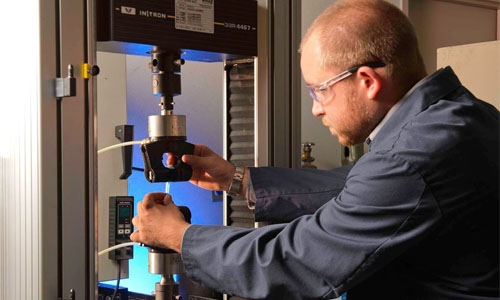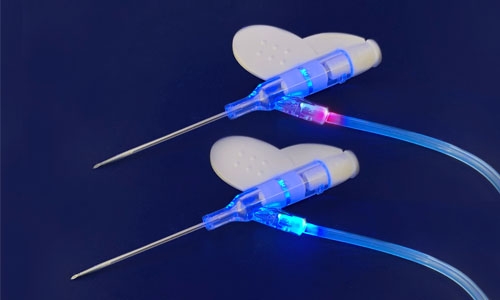了解性能、安全性和效率的关键因素
在医疗器械胶粘剂,风险极高。医疗专业人员依赖于通常可以挽救生命的设备的性能、安全性和可靠性。实现正确的粘合不仅对产品的功能至关重要,而且对于确保患者安全也至关重要。从各种可用选项中选择最佳粘合剂似乎很困难,但通过关注特定标准,工程师和制造商可以做出明智的最佳选择。
医疗胶粘剂选择背后的化学原理
当使用工程塑料(聚碳酸酯、丙烯酸、ABS、尼龙)等材料与金属或玻璃组装医疗设备时,粘合剂化学性质成为关键决策点。有多种粘合剂类型可用于不同的材料组合:从光固化丙烯酸聚氨酯到快干胶、单组分或双组分环氧树脂,甚至结合了热固化和光固化功能的混合系统。
对于医疗器械制造商来说,最关键的考虑因素之一是生物相容性,因为这些设备经常与人体直接接触。该领域常用的粘合剂,如光固化丙烯酸聚氨酯,具有在光照下快速固化的优点,使其成为透明塑料的理想选择。根据特定的粘接和材料兼容性要求,快干胶酯、柔性聚氨酯和刚性环氧树脂也被广泛使用。
粘度:找到正确的流动特性
粘度,即流体流动阻力的量度,是选择用于医疗器械胶粘剂的合适粘合剂的另一个重要参数。所选粘合剂必须满足组装工艺的要求,无论是灌封、填充凹槽还是施加精确的珠子。
将粘合剂涂到管子上RotoSpense 360 工作站
对于从事医疗器械制造的工程师来说,控制粘度是关键。如果组装过程涉及填充间隙或灌封,则最好使用较低粘度的流体。但是,对于需要珠状或点状粘合剂的应用,粘度较高或触变性材料可能更合适。触变性材料在剪切下(例如在应用过程中)容易流动,但一旦剪切消除就会变稠。当精确放置粘合剂至关重要时,这种行为特别有用,因为它可以防止不必要的扩散。
了解这些细微差别有助于确保所选的粘合剂满足设备的性能和可制造性要求。
粘合:优化粘合强度和耐久性
选择最佳粘合剂还需要考虑设备性能所需的特定粘合特性。医疗设备通常要经过严格的机械测试,例如搭接剪切或剥离力测试,以确保在预期负载下的粘合完整性。
应用工程师使用 Instron 进行机械测试。
粘合剂在此类测试中的性能通常取决于所用材料、表面处理和固化条件。在某些情况下,组件必须经过加速老化模拟长期使用,特别是在高温或高湿等恶劣环境下。然而,突破这些老化测试的极限有时会适得其反,尤其是对于粘合剂而言。过度暴露于极端条件下会改变粘合剂的性质,降低其柔韧性或伸长率,从而导致现场过早失效。
因此,选择在类似应用和条件下具有经过验证的性能的粘合剂以确保可靠性和使用寿命至关重要。
易于加工:制造效率的关键
对于医疗器械制造商来说,效率与性能同样重要。粘合剂会极大地影响生产速度和成本,尤其是在选择单组分和双组分系统时。单组分粘合剂(如丙烯酸聚氨酯)通常因其简单性而受到青睐。它们不需要复杂的计量系统,加工步骤较少,并且无需系统清洗,因此非常适合大批量生产。
此外,固化过程也起着至关重要的作用。 光固化胶粘剂可以通过按需固化大大加快生产时间。然而,重要的是要评估粘合剂能否轻松集成到现有生产线中,无论组装是手动、半自动还是全自动。
制造商还必须考虑生产过程中可能出现的中断,例如生产线停工或粘合剂性能变化,这些都可能影响性能。确保粘合剂能够应对这些挑战对于避免停机和降低废品率至关重要。
生物相容性和监管考虑
在医疗器械应用中,生物相容性是不可妥协的。这些组件中使用的粘合剂必须符合 ISO 10993 或 USP VI 级等严格标准,以确保它们在医疗环境中安全使用。
这些测试通常在完全固化的粘合剂样品上进行,但制造商也必须进行自己的测试,以确认最终产品中使用的粘合剂仍然符合要求。固化时间和方法等因素会影响粘合剂的生物相容性,因此必须密切关注整个组装过程。
医疗器械中使用的大多数粘合剂都与常见的灭菌方法,例如环氧乙烷 (EtO) 和伽马射线灭菌。然而,高压灭菌耐受性通常仅限于几个循环,这可能是根据设备的预期用途而考虑的因素。
通过创新解决方案提高质量
确保高质量粘合对于医疗器械的可靠性至关重要。一些先进的粘合剂采用发荧光的粘合剂,便于在紫外线下进行检查。此功能使制造商能够确保粘合剂覆盖整个粘合线并揭示任何潜在缺陷,如气泡或空隙。
导管用荧光胶粘合以进行质量检查。
创新,例如 See-Cure 技术,增加了额外的质量控制层。这些粘合剂一旦完全固化就会变色,即使在复杂的组装中也可以轻松验证粘合剂是否已完全固化。该技术可帮助制造商,因为它有助于在组装过程中建立安全系数。
Encompass®是另一项将 Dymax 专利 See-Cure 变色和 Ultra-Red® 荧光技术相结合的创新发明。当该技术被配制到 Dymax医疗器械胶粘剂中时,用户能够看到光固化材料被放置在组件上的位置,并确保它在从亮蓝色变为无色后完全固化。
Ultra-Red 荧光功能使粘合剂保持无色,直到暴露于低强度紫外线下,此时它会发出鲜红色的荧光。鲜艳的颜色与自然发出蓝色荧光的塑料和其他基材形成鲜明对比,有助于目视检查粘合线或涂层区域。Ultra-Red® 技术还会产生独特的光谱特征,可用于产品认证。
因此,制造商可以通过 Encompass 技术实现快速、按需固化,并轻松进行固化确认和固化后粘合线检查,从而提高效率。
真实成本与价格:了解粘合剂的价值
成本是一个重要的考虑因素,但仅仅关注每克粘合剂的价格可能会产生误导。使用粘合剂的总成本涉及减少浪费、加工效率和维护等因素。例如,更昂贵的光固化胶粘剂可以通过减少固化时间和最大限度地减少停机时间来节省大量成本。
在整个制造过程中对粘合剂进行评估可确保所选材料提供最佳价值,而不仅仅是最低价格。
结论:与专家合作以获得最佳结果
选择适合医疗器械胶粘剂的粘合剂需要平衡多种因素,包括化学性质、粘度、粘合性和加工需求。通过与了解医疗器械制造独特挑战的粘合剂供应商合作,工程师可以确保可靠的粘合、最佳性能和长期的器械安全性。
实验室技术人员合作开展一个项目。





